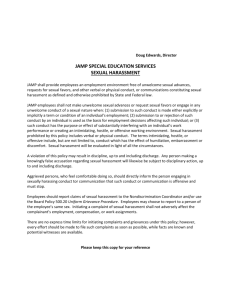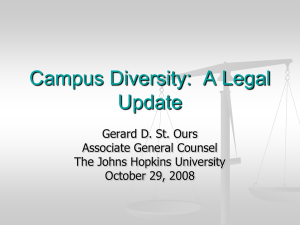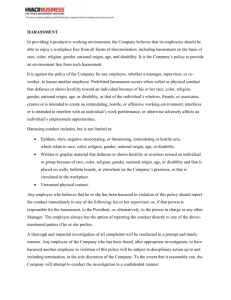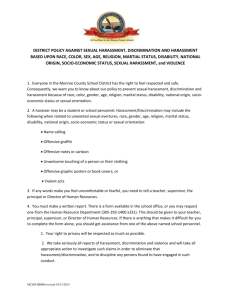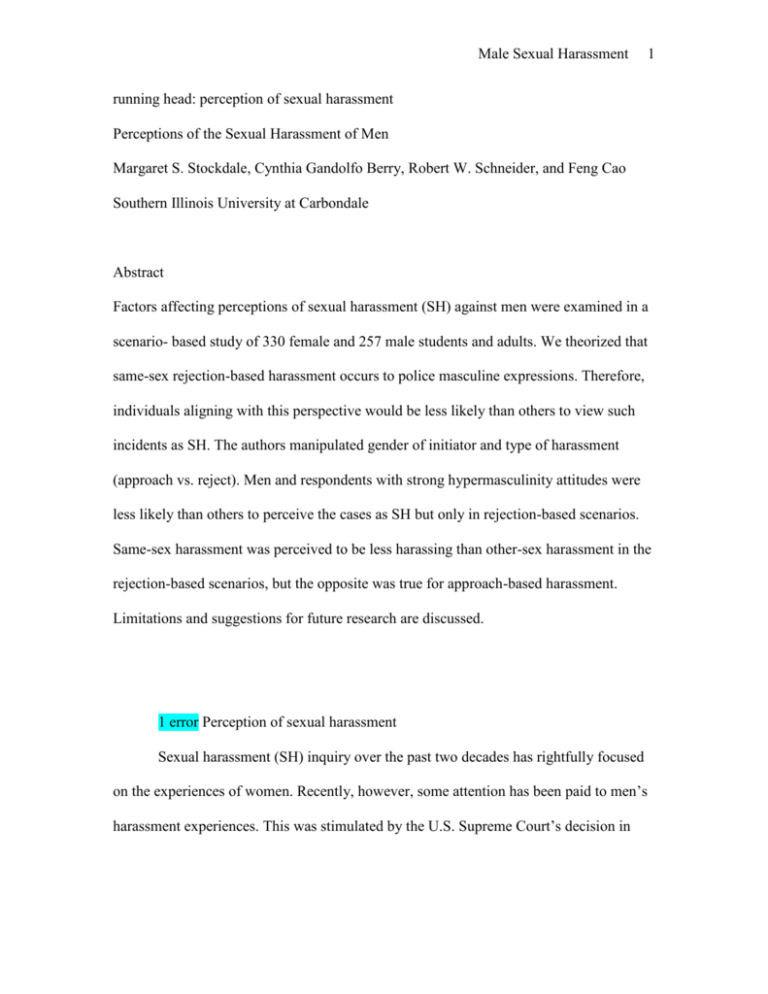
Male Sexual Harassment
1
running head: perception of sexual harassment
Perceptions of the Sexual Harassment of Men
Margaret S. Stockdale, Cynthia Gandolfo Berry, Robert W. Schneider, and Feng Cao
Southern Illinois University at Carbondale
Abstract
Factors affecting perceptions of sexual harassment (SH) against men were examined in a
scenario- based study of 330 female and 257 male students and adults. We theorized that
same-sex rejection-based harassment occurs to police masculine expressions. Therefore,
individuals aligning with this perspective would be less likely than others to view such
incidents as SH. The authors manipulated gender of initiator and type of harassment
(approach vs. reject). Men and respondents with strong hypermasculinity attitudes were
less likely than others to perceive the cases as SH but only in rejection-based scenarios.
Same-sex harassment was perceived to be less harassing than other-sex harassment in the
rejection-based scenarios, but the opposite was true for approach-based harassment.
Limitations and suggestions for future research are discussed.
1 error Perception of sexual harassment
Sexual harassment (SH) inquiry over the past two decades has rightfully focused
on the experiences of women. Recently, however, some attention has been paid to men’s
harassment experiences. This was stimulated by the U.S. Supreme Court’s decision in
Male Sexual Harassment
2
Oncale v. Sundowner Offshore Services, Inc. (1998) that Title VII covers same-sex SH
and by a growing interest in the completeness of SH theory (Franke, 1997).
1 error The Equal Employment Opportunity Commission’s (1980) definition of
SH has been adopted as the legal definition (see Meritor Savings Bank FSB v. Vinson,
1986). It outlines two illegal forms of SH: (a) quid pro quo, or the conditioning of
tangible employment benefits on sexual cooperation, and (b) hostile work environment,
or the subjugation of employees to severe and pervasive unwanted sexual behavior
because of their sex that has the effect of substantially interfering with the work
environment. In contrast, behavioral definitions of SH that focus on the constellation of
events that could be construed as harassing cluster into three or four categories (e.g.,
Fitzgerald, Swan, and Magley, 1997): (a) gender harassment, which is behavior not
aimed at sexual cooperation but conveys insulting, hostile, and degrading attitudes about
women (in some studies [e.g., Stockdale, Visio, & Batra, 1999], this has broken into two
factors: sexist hostility, or being treated differently because of your sex, and sexual
hostility, or being subjected to humiliating sexual stimuli); (b) unwanted sexual attention
(unwanted verbal and nonverbal sexual behavior intended to attract sexual attention); and
(c) sexual coercion (the extortion of sexual cooperation in return for job-related
considerations).
1 error Research focusing specifically on male SH began to appear in the late
1990s. Berdahl, Magley, and Waldo, 1996, noted that men regard negotiations of gender
in the workplace that challenge male dominance as sexually harassing. Examples of this
behavior include ridiculing a man for doing things women normally do (such as taking
time off to help with a new baby).
Male Sexual Harassment
3
1 error One clear difference between male and female targeted SH is that men are
much more likely to experience same-sex SH (SSSH) than are women (DuBois, Knapp,
Faley, & Kustis, 1998; Stockdale et al., 1999). For example, surveys of federal
employees have shown that approximately 21% of harassed men experienced SSSH
compared with about 1%–3% of harassed women (U.S. Merit Systems Protection Board,
1981, 1995). After examining significant court cases of male SH and systematically
examining the nature of men’s SH experiences from the U.S. Department of Defense’s
(DoD) large-scale SH survey, Stockdale, Visio, and Batra (1999; see also Stockdale, in
press) noted that men who experienced SSSH were more likely than men experiencing
other-sex SH (OSSH) to be the targets of sexual hostility, or behaviors designed to tease
and humiliate the target. OSSH targets tended to experience either sexist comments by
women or unwanted sexual attention. Furthermore, compared with OSSH targets, SSSH
targets tended to be young and in subordinate positions (Stockdale et al., 1999).
We know little about how people view SH against men. We distinguish approachfrom rejection-based harassment as well as SSSH versus OSSH to better understand the
potential vagaries in the perception of SH of men.
In addition to this intricate examination of SSSH and OSSH vis-a`-vis approachand rejection-based harassment, this study aimed to explore the direct relationship
between perceiver gender and perceptions of male SH.
Rater Gender
1 error Three meta-analyses have supported the hypothesis that women are more likely to
interpret unwanted social–sexual behavior as harassing than are men, especially when the
behavior or scenario is ambiguous (Blumenthal, 1998; O’Connor, 1998; Rotundo,
Male Sexual Harassment
4
Nguyen, & Sackett, 2001). Self-referencing, which is using oneself as a referent in
deciding whether SH occurs (O’Connor et al., 2004; Wiener & Hurt, 2000), and harm
avoidance (Jensen & Gutek, 1982, Shaver, 1970) have been forwarded as explanations
for this gender difference (see also Kenig & Ryan, 1986, Summers & Myklebust, 1992).
Harm avoidance theory (Shaver, 1970), posits that perceivers who view themselves as
similar to the victim (e.g., SH target) are motivated to avoid similar harm, thus they are
less likely to blame the victims for the accident or harassment. Perceivers who view
themselves as potentially being blamed for a similar incident as the perpetrator are
motivated to avoid blame. Thus, they are more forgiving toward the perpetrator and more
likely to blame the victim. The self-referencing hypothesis would predict that women will
be more sensitive than men to male SH because they can put themselves in the victim
role more easily. The harm avoidance hypothesis predicts that men will be more sensitive
than women to male SH because of gender similarity with the target.
1 error Although gender-based similarity biases have been noted in studies on jobapplicant favorability ratings (Gallois, Callen, & Palmer, 1992; cf. Graves & Powell,
1995; Smith & Callum, 1996), perceived similarity appears to be a more potent predictor
of favorability bias than simple demographic similarity (Pulakos & Wexley, 1983; Liden,
Wayne, & Stilwell, 1993). Men may negatively view or distance themselves from other
men who claim to have been sexually harassed, and therefore male raters may not
perceive themselves to be similar to a man complaining of SH. Thus, we hypothesize that
women will be more sensitive than men to SH judgments of men. Furthermore, consistent
with Wiener and Hurt’s (2000) speculation that women, more than men, would
Male Sexual Harassment
5
selfreference their judgments of male SH, we hypothesize that self-referencing judgments
will mediate the relationship between rater gender and SH judgments.
Method
Participants and Procedure
Two samples were collected for this study. The first consisted of 343
undergraduates (45% male) enrolled in a general psychology course at a Midwestern
university who participated in the study for course credit. Their average age was 21.20
years (SD 3.89); 63% were White, 22% were Black–African American, 6% were
Hispanic, 3% were Indian– Eskimo, 5% were Asian, and 1% were other. Participants
completed the study materials in groups of 2–15, although they worked independently.
They were given one of eight scenarios1 to read and the accompanying rating forms to
complete.
For the manipulation check study, 40 male and 40 female undergraduate students
enrolled in a general psychology course read one of the eight scenarios and completed a
survey designed to assess the perceived intentions of the alleged harasser. Their task was
to determine whether the scenarios were perceived as composing rejection- or approachbased intentions.
Materials
Measures.
2 errors The survey contained items measuring personal and legal definitions of
harassment, selfreferencing items, other follow-up questions, measures of sexism, and
demographic information. With few exceptions, the survey questions were identical to
the survey used in Gutek et al. (1999). Specifically, the respondent’s personal definition
Male Sexual Harassment
6
of harassment was measured with the following item: “In your opinion was Bill Smith
sexually harassed?” Because both cases described a hostile work environment, as
opposed to quid pro quo harassment, only the legal definition of the former was asked.
The legal definition of hostile work environment was written on the survey,2 and
respondents answered two questions concerning the extent to which they believed a
hostile work environment existed at the company (“Would a reasonable person have
perceived New Era Shoes, Inc. to be a hostile work environment?” and “Do you think
that a jury would decide that a hostile work environment existed at New Era Shoes,
Inc.?”). These items were combined to form a hostile work environment (HWE) scale (A
= .70). Two additional items were modeled after Wiener and Hurts work on selfreferencing: “If the things that happened to Bill Smith had happened to you, would you
consider it to be sexual harassment–inappropriate?” These items were combined to form
a selfreferencing scale (A = .73). An additional question asked if the respondent were a
coworker of Bill Smith, would he or she be willing to testify to an investigation team on
Bill’s behalf (in support of Bill’s claim of SH). All the items described above were
answered on 6-point scales ranging from 1 (no, not at all) to 6 (yes, definitely).
Participant sexism was measured with the Hypermasculinity Inventory (HI;
Mosher & Sirkin, 1984). This scale measures the macho personality construct, which
consists of a constellation of calloused sex attitudes toward women, a conception of
violence as manly, and a view of danger as exciting. The 30-item forced-choice scale is
unidimensional, with good reliability (A = .91). Thompson and Pleck (1995) noted that
the HI has strong construct validity but that it may be limited for use with a heterosexual
population only. Thompson and Pleck also noted that the HI is a distal indicator of the
Male Sexual Harassment
7
social forces on men’s behavior and therefore is relevant only to the extremes in male
behavior. However, this is the type of construct of interest in this study. We propose that
extreme masculine gender-role identification, or hypermasculinity, accounts for apathy in
the perception of male SH.
For the manipulation check study, we used an 18- item scale with Likert-type
items assessing the perceived intent of the harassment initiator’s behavior. Anchors
ranged from 0 (not at all) to 4 (very large extent). Principal-components analysis with
varimax rotation revealed a four-component solution, with simple structure accounting
for 74% of the variance. Subscales were created by averaging items that loaded on their
respective components: Sexual Attraction (4 items; e.g., “wanted to establish a sexual
relationship with you;” α = .97), Rejection (5 items; e.g., “was trying to reject you,”
“wanted to humiliate you;” α = .91), Joking (5 items; e.g., “was having fun without
meaning to hurt anyone;” α = .80), and Friendship (4 items; e.g., “considered you to ‘fit
into’ their group,” “considered you to be a close friend;” α = .74).
Results
Manipulation Check
1 error A 2 (type of harassment: approach vs. rejection) x 2 (gender of harasser) x
2 (gender of participant) multivariate analysis of variance (MANOVA) was conducted on
the manipulation check scales: Sexual Attraction, Rejection, Joking, and Friendship. The
multivariate F was significant for type of harassment (Wilks’s Λ = .21), F(4, 66) =
61.45, p < .001, and gender of harasser (Wilks’s Λ = .73), F(4, 66) = 6.03, p < .001.
For type of harassment, univariate follow-up tests found significant effects for three of
the scales: Sexual Attraction, F(1, 69) = 225.74, p < .001, η2 = .77; Rejection, F(1, 69) =
Male Sexual Harassment
8
44.79, p < .001, η2 = .40; and Friendship, F(1, 69) = 4.46, p < .05, η2 = .06. The means
indicated that the approach scenario was rated higher than the rejection scenario on
Sexual Attraction motive (approach: M = 3.17, SD = 0.90; rejection: M = 0.47, SD =
0.71) and the Friendship motive (approach: M = 0.72, SD = 0.81; rejection: M = 0.40,
SD = 0.63), whereas the opposite was true for the Rejection motive (approach: M = 1.39,
SD = 1.10; rejection: M = 2.83, SD = 0.85). Thus, we concluded that the approach and
rejection scenarios accurately reflected their intended motives.
Discussion
Our research helped to generalize findings from past research on female SH to
understanding male SH. Consistent with this body of research, sexist attitudes
(hypermasculinity) and respondent gender exerted main effects on SH perceptions.
Specifically, men and individuals who endorsed hypermasculinity beliefs were less likely
to perceive the scenarios as SH than did women or nonsexist individuals. These effects,
albeit small, were consistent across both student and nonstudent adult samples. However,
these effects were qualified by important interactions with the type of harassment.
Rejection-based SH, the form that Berdahl et al. (1996) identified as involving
“negotiations of gender,” was perceived as less harassing when committed by male
perpetrators, by male respondents, and by individual’s possessing strong
hypermasculinity attitudes. These factors did not affect the perception of approach-based
harassment, a form typically committed by women and not considered to entail a genderpolicing function. The findings from this study, therefore, lend support to the theory that
some forms of male SH may be motivated by sexist motivations to control men’s
Male Sexual Harassment
9
masculine expressions in the workplace and that individuals who align with this belief
system are less likely than others to view such incidents as SH.
Although all of the hypotheses were generally supported, the unexpected
crossover interaction between gender of perpetrator and type of harassment on hostile
work environment ratings poses an interesting trajectory for future research. As expected,
SSSH was considered less harassing than OSSH in the rejection condition, but in the
approach condition, SSSH was considered to be significantly more harassing than OSSH.
Approach-based SSSH is quite possibly viewed as homosexually motivated harassment,
and people may regard this as particularly threatening for men (it’s also an empirical
question whether people view homosexually motivated harassment against women to be
threatening). In the past, SH against men has been dismissed as unimportant (cf. Vaux,
1993, for a discussion), probably because only experiences or perceptions of
approachbased OSSH have been examined, which men typically find to be amusing or at
least not serious (see Gutek, 1985). Our investigation of SSSH suggests that some forms
of male SH may indeed be considered quite threatening. However, it should be noted that
survey research finds approach-based SSSH to be much more rare than rejection-based
SSSH. Thus, homosexually motivated harassment may be a potential, but nonprevalent,
threat to men.
Consistent with past research on female harassment, women were more likely
than men to judge cases of male SH as harassing. Furthermore, consistent with Wiener
and Hurt’s (2000) prediction, selfreferencing accounted for this gender difference. This
finding lends credence to the view that situational or contextual similarity is more potent
than demographic similarity in being able to put oneself in the target’s shoes, so to speak.
Male Sexual Harassment
10
1 error Further research on self-referencing is needed to more precisely determine
how it operates. One speculation is that individuals who have had prior experience with
SH are more sensitive to the perception of SH and thus are more likely to use that
experience as a reference for judging others’ claims of SH. Stockdale, O’Connor, Gutek,
and Geer (2002) found no support for any consistent relationship between prior sexual
victimization experiences (SH or other) on SH perceptions (see also D. Fitzgerald, Q.
Buchanan, C. Collinsworth, L..G. Magley, & L.A. Ramos, 1999). Although some
individuals may use their prior sexual victimization– SH as a reference for judging
current harassment claims, it is possible that a current claim may seem too trivial in
comparison to the perceiver’s prior experience or not relevant at all. Further development
and understanding of the self-referencing concept is needed.
In summary, sexism and SH have long been interconnected in our understanding
female SH (see Franke, 1997). This study helps show that sexism can be an integral part
of male SH as well. People who align with a sexist patriarchal worldview are particularly
insensitive to same-sex rejection-based harassment against men—a form of harassment
that is particularly prevalent for men.
Male Sexual Harassment
11
References
Author: Gutek, B. A.
Year: 1985
Book Title: Sex and the workplace: Impact of sexual behavior and harassment on women,
men, and organizations.
Publisher: San Francisco, Jossey-Bass.
Authors: Gutek, B. A., O’Connor, M. A., Melancon, R., Stockdale, M. S., Geer, T. M.,
and Done, R. S.
Year: 1999
Article title: The utility of the reasonable woman legal standards in hostile environment
sexual harassment cases: A multimethod, multistudy examination.
Journal title: Public Policy, Psychology, and Law,
Volume: 5,
Pages: 596–629.
Author: O’Connor, M. A.
Year: 1998
Title: Gender and the definition of sexual harassment: A meta-analysis of the empirical
literature.
Male Sexual Harassment
Extra information: This is an unpublished doctoral dissertation presented as part of the
requirements of a doctoral degree from the Department of Psychology, University of
Arizona.
Court Case: Oncale v. Sundowner Offshore Services, Inc., 118 S. Ct. 998 (1998).
Authors: Rotundo, M., Nguyen, D., and Sackett, P. R.
Date: 2001
Title: A metaanalytic review of gender differences in perceptions of sexual harassment.
Journal title: Journal of Applied Psychology
Volume: 86
Pages: 914–922.
Authors: Stockdale, M. S.
Date: (in press)
Chapter Title: The sexual harassment of men: Articulating the approach–rejection
distinction in sexual harassment motives.
Book information that chapter is in:
Authors: J. E. Gruber and P. Morgan (Eds.)
Book title: In the company of men: Rediscovering the links between sexual
harassment and male domination.
Publisher: Northeastern University Press, Boston.
12
Male Sexual Harassment
13
Margaret S. Stockdale, Cynthia Gandolfo Berry, Robert W. Schneider, and Feng
Cao, Department of Psychology, Southern Illinois University at Carbondale. We thank
Barbara A. Gutek for her helpful suggestions for this research, her insightful comments,
and critical review of this article. We also thank Eric Sites, Timothy Hargett, and Anne
Azevedo for their efforts on earlier versions of this research and for their assistance with
data collection. Correspondence concerning this article should be addressed to Margaret
S. Stockdale, Department of Psychology, Southern Illinois University, Carbondale, IL
62901- 6502. E-mail: pstockdale@siu.edu Psychology of Men & Masculinity Copyright
2004 by the Educational Publishing Foundation 2004, Vol. 5, No. 2, 158–167 15249220/04/$12.00 DOI: 10.1037/1524-9220.5.2.158 158
Footnote
1We also manipulated how the target responded to the harassment (remained
silent and tolerated the behavior or actively complained to a supervisor about the
behavior), but this factor was not the focus of the current study. All effects discussed in
this study are combined over this factor.
Male Sexual Harassment
14
Data for table: Include one table using the information below. The basic structure should
look like this, but of course this is not in APA format.
SH rating and variable
Step 1
Step 2
2
β
sr
β
sr2
Personal definition
1. Sexa
.14**
.02
-.04
2. Self-referencing
.535***
.25
HWE
1. Sexa
.08*
.01
-.03
2. Self-referencing
.339**
.10
HWE
1. Sexa
.15**
.02
-.03
2. Self-referencing
.519**
.24
Title of table: Mediation Analysis Assessing Self-Referencing as Mediator of the Sex–SH
Rating Relationship
Table note: SH sexual harassment; HWE hostile work environment.
a
Coded as 0 = male, 1 = female.
*p < .05. **p < .001.
Create a Figure in Excel based on this model
Personal
Would
Gender
definition
Testify
Male
46.25
33.2
Female
66.65
55.7
Sexual Harassment Value
Male
HWE
Self-reliance
14.6
71.2
20.9
99.5
Female
Sample
120
99.5
100
80
60
71.2
66.65
55.7
46.25
33.2
40
14.6
20
20.9
0
Personal
definition
Would Testify
HWE
Criteria
Figure Caption: Sexual Harassment value by Gender
Self-reliance







